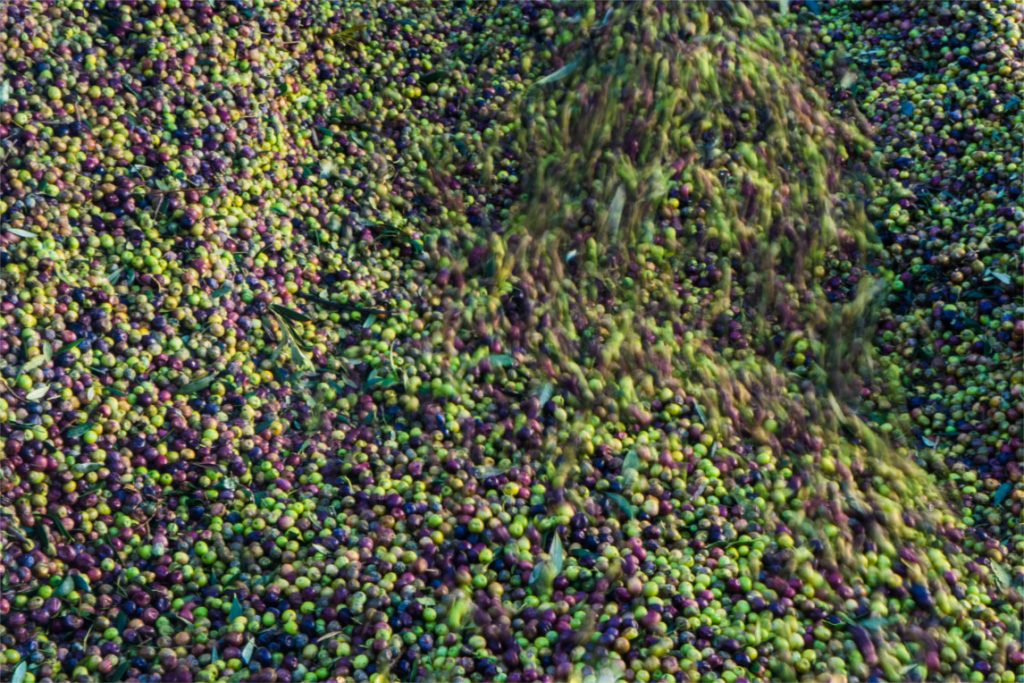Olive oil types available in the market
There are different olive oil types available in the market. We can divide them first in Virgin or Refined. Then we will go deeper and explain the different olive oils that consumers can find doing their grocery shopping and others that you may have never seen before.
All the olive oils come from the fruit of the olive tree (Olea europaea). This fruit is the olive. When we harvest the olives and we grind them. As a result, we obtain a mixture of olive oil, water and solids (these solids come from the olives skins and bones). The olive oil obtained by grinding the olives using only mechanical means (grinding, blending, centrifugation and filtering) is the virgin olive oil.

Legal classification of olive oils in the European Union
-
Virgin olive oils
Depending on their quality we have three kinds of virgin olive oils. This classification is stated by the European Union law, Regulation (EU) No 29/2012. Definitions of each olive oil are in italic, and it is compulsory to include them in the labels of the olive oil bottles. These are the kind of olive oils that we can find in an almazara or olive oil mill.
-
Extra virgin olive oil: ‘superior category olive oil obtained directly from olives and solely by mechanical means’. It is the highest quality virgin olive oil. The extra virgin olive oil has an acidity level under 1º and it has to be approved by an independent expert tasting panel to be considered extra virgin.
-
Virgin olive oil: ‘olive oil obtained directly from olives and solely by mechanical means’. It is the virgin olive oil that is not considered extra virgin because it has a level of acidity over 1º. Virgin olive oil is still good quality olive oil and it is safe to consume.
-
Lampante olive oil: lampante is the bad quality virgin olive oil. It has high acidity and it is not edible. This happens when the olives are harvested very late or the olive oil is obtained from olives that have fallen from the tree or have suffered some degradation process. Its name comes from the Spanish word “lámpara” which means “lamp”. That is because this oil was used to be burned in oil lamps in the past.
-
Refined olive oils
We said earlier on that when we grind the olives you separate the olive oil from the water and the solids of the olive. The solids and the water are mixed in a substance called alperujo (this word is a mix of the words alpechin and orujo).
The lampante olive oil and the alperujo are not suitable for human consumption. These products need to be refined so that people can eat them. The process of refining consists of using chemicals to extract all the fats and after that, they remove the acidity and wax present in the olive oil. During this process, all the flavours and micronutrients of the virgin olive oil are lost. After this process, you obtain a fat with no flavour or odour, which is named pomace oil.
Refining process steps
From lampante olive oils and/or from the olive solids (alperujo) we obtain the refined olive oils:
-
Olive oil composed of refined olive oils and virgin olive oils: ‘oil comprising exclusively olive oils that have undergone refining and oils obtained directly from olives’. It is known as Olive oil or “pure olive oil”: is the blend of more than 95% of refined lampante olive oil with a small amount of extra virgin olive oil to give it a little bit of flavour. They are normally labelled as mild or intense and they state the acidity level on the label (0,3º-0,4º).
-
Olive-pomace oil: ‘oil comprising exclusively oils obtained by treating the product obtained after the extraction of olive oil and oils obtained directly from olives’ or: ‘oil comprising exclusively oils obtained by processing olive pomace and oils obtained directly from olives’. It is the product obtained by refining the lampante olive oil and the alperujo after removing all the flavour, aroma, and particles. It is a fat similar to the seed refined oils like rapeseed oil or sunflower oil.
Extra virgin olive oils. Are they all the same?
- enlace a blog de la cosecha de la aceituna
Now that you understand better the legal classification of olive oils we are going to focus on extra virgin olive oils. In Reinos de Taifas we are specialist in Single Variety extra virgin olive oils. But we haven´t mention Single Variety in our legal classification at all. That is because inside the extra virgin olive oil category you can find many subcategories that we are going to explain to you.
Single Variety vs Coupage
When we say that an extra virgin olive oil is Single Variety we mean that the extra virgin olive oil comes 100% from the same cultivar of an olive tree. All the olives ground to obtain this extra virgin olive oil are from the same variety or species.
Coupage olive oils come from a mix of different cultivars of olive trees. This coupage could be made intentionally by selecting Single Variety olive oils and mixing them in certain proportions to obtain a specific olive oil flavour. Coupage could also mean that they harvest all the olive trees at the same time and they grind all the olives together so they cannot control the varieties involved because that process would be more expensive.
Early harvest vs late harvest
Early harvest extra virgin olive oils are obtained at the beginning of the harvest season, in November or December depending on the year. Early harvest extra virgin olive oils are fresher and they have a more intense flavour and green colour due to their chlorophyll content. They also contain more polyphenols and other antioxidants and micronutrients, which are the components that make extra virgin olive oils healthier.
Late harvest olive oils are obtained when the olives are more mature, in January or February. The olives offer a higher yield than early harvest olive oils, but the quality of the olive oils is lower. Their colour is less green and they may fall into the categories of Virgin or Lampante rather than extra virgin.
H3 Ecologic vs traditional
H3 Filtered vs unfiltered
H3 Cold press or cold-extraction
H3 Intense and mild olive oils
H3 Night harvesting
In super-intensive crops
H2 Health effect of the different kinds of olive oil
H2 Environmental impact of the different kinds of olive oil

